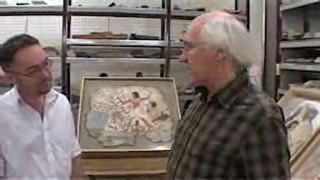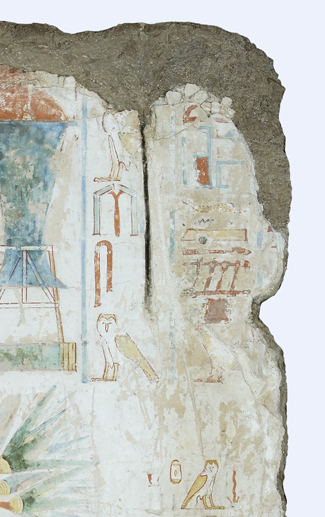6 Acquisition of the paintings
In this section you will learn how the fragments were selected and removed from the walls of the tomb-chapel.
When Nebamun’s tomb was discovered in 1820 the paintings were literally wrenched from their setting with saws and crowbars. No attention was paid to the possible meanings of the scheme as a whole (which in many cases were inaccessible because the script had not yet been deciphered), and, incredible as it may seem to the twenty-first-century mind, no record was kept of the whereabouts of the site.
This was partly deliberate secrecy because of the rivalry between collectors, and what could be expected from the sale of good specimens to museums and private collections in Europe. Even at the time, the practice of stripping works of art from their sites was not uncontroversial. A letter of 1835 lamented d’Athanasi’s habit of ‘destroying Tombs under a false idea of preserving them’, and referred to the cutting-out of paintings as ‘a most destructive process’. [Hay, quoted in Parkinson p. 13]
It is important to recognise however that these transactions were legal at the time, and indeed involved the knowledge of the Egyptian government. Salt and d’Athanasi and others like them were trying to preserve relics of a lost civilisation, nor was it in any simple sense a matter of private gain, for the artefacts were for the most part due to be offered to the then-emerging major European museums. Having said that, it remains the case that the Enlightenment project of acquiring knowledge was often but a step away from a cruder form of acquisition, as well as being implicated in more overtly political Anglo-French rivalries following the Napoleonic wars.
Watch this video in which Richard Parkinson and Paul Wood talk about how the fragments came to be in the British Museum

Transcript
Depending on where one stands at the present time, it is equally easy to regard this as a regrettable price to be paid for pioneering knowledge-work, or the symptom of a wider imperialist plunder of the rest of the world. This opens up a complex range of questions about the relationship of knowledge and power and the ethics of major museum collections which loom large in early twenty-first-century debate, but which would take us beyond the scope of the present course.
Whichever stance one assumes on this issue of the acquisition of the paintings, however, there remains something intriguing about the operation itself – that is, the operation of physically getting the pictures (Figure 25) – that raises it out of mere acquisitiveness and reveals it to have involved a considerable and complex cultural transaction.

